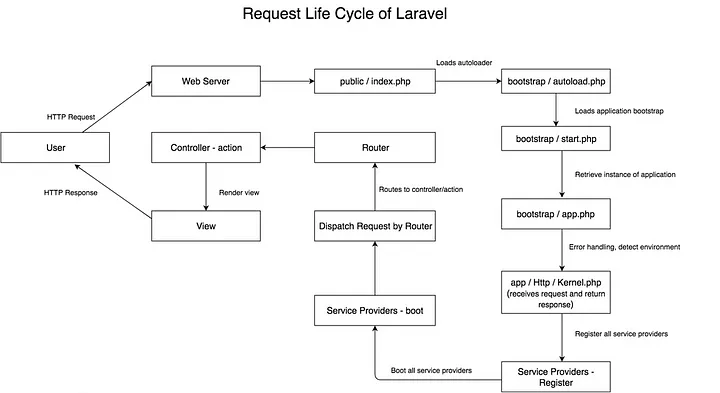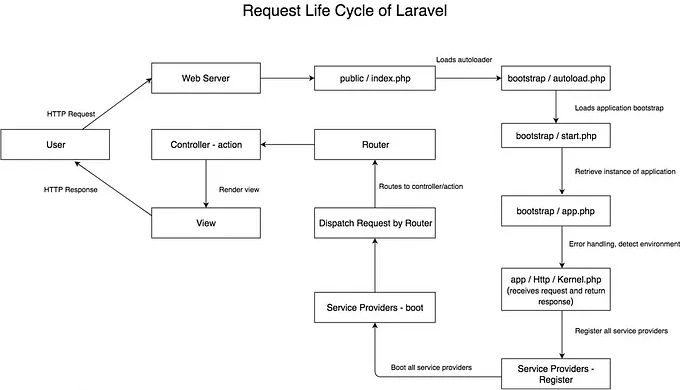Request Lifecycle in Laravel
How things flow in a Laravel app?
“you feel more confident if you understand how that tool works”
lifecycle
a sequence of events and actions that occur during the execution of a request. Each request goes through several stages, and Laravel provides various mechanisms to perform actions at different points in this lifecycle

Do you know?
The first-ever website, created by Tim Berners-Lee, went live on August 6, 1991. It was a simple page describing the World Wide Web project and how to use hypertext to access documents.
Index.php – The ENTRY point
All requests are directed to this file by your web server (Apache / Nginx) configuration. The index.php file doesn’t contain much code. Rather, it is a starting point for loading the rest of the framework.
The index.php file loads the Composer generated autoloader definition, and then retrieves an instance of the Laravel application from bootstrap/app.php.
Do you know?
Rasmus Lerdorf created PHP (Personal Home Page) in 1994, originally as a simple tool to track visitors to his online resume.
Autoloader
An autoloader in Laravel is like a smart library organizer for your code. It automatically finds and loads the right files when you use different parts of your Laravel project. This way, you don’t have to search for and include files manually, making your coding life easier and more organized.

HTTP / Console Kernels
The incoming request is sent to either the HTTP kernel or the console kernel, depending on the type of request that is entering the application. These two kernels serve as the central location that all requests flow through.
Which of the following is responsible for processing HTTP middleware in Laravel?
- a) Kernel
- b) Router
- c) Controller
- d) View
Which of the following is responsible for processing HTTP middleware in Laravel?
- a) Kernel
- b) Router
- c) Controller
- d) View
The correct answer is a) Kernel. The Kernel class in Laravel is responsible for processing HTTP middleware, which includes actions like verifying authentication, etc.
The HTTP kernel extends the Illuminate\Foundation\Http\Kernel class, which defines an array of bootstrappers that will be run before the request is executed. These bootstrappers configure error handling, configure logging, detect the application environment, and perform other tasks that need to be done before the request is actually handled. Typically, these classes handle internal Laravel configuration that you do not need to worry about.
The HTTP kernel also defines a list of HTTP middleware that all requests must pass through before being handled by the application. These middleware handle reading and writing the HTTP session, determining if the application is in maintenance mode, verifying the CSRF token, and more.
Do you know?
Web 2.0: Coined around 2004, the term “Web 2.0” represented a shift in focus from static web pages to more dynamic and user-centered experiences, including social media, user-generated content, and interactive web applications.

Service Providers
One of the most important kernel bootstrapping actions is loading the service providers for your application. Service providers are responsible for bootstrapping all of the framework’s various components, such as the database, queue, validation, and routing components. All of the service providers for the application are configured in the config/app.php configuration file’s providers array.
Laravel will iterate through this list of providers and instantiate each of them. After instantiating the providers, the register method will be called on all of the providers.
When you register a service provider, Laravel goes through a series of steps to set up and configure various components of your application. The boot method is called after the registration phase and before the application starts handling requests.
During the boot method, service providers have the opportunity to interact with the Laravel application and its components. They can perform tasks like registering routes, binding interfaces to implementations, setting up event listeners, and more. These tasks are essential to ensure that the various parts of your application are properly configured and ready to work together seamlessly.
What is the primary role of a Service Provider in Laravel?
- a) Handling HTTP requests
- b) Defining database schema
- c) Managing middleware
- d) Registering application services
What is the primary role of a Service Provider in Laravel?
- a) Handling HTTP requests
- b) Defining database schema
- c) Managing middleware
- d) Registering application services
- Explanation: The correct answer is d) Registering application services. Service Providers in Laravel are responsible for bootstrapping and registering various services, such as bindings, middleware, routes, and more, during the application’s lifecycle.
Which directory contains the default Service Providers included with Laravel?
-
- a) app/Providers
- b) config/Providers
- c) resources/Providers
- d) app/Services
Which directory contains the default Service Providers included with Laravel?
-
- a) app/Providers
- b) config/Providers
- c) resources/Providers
- d) app/Services
“Anything worth doing is going to be difficult”

Dispatch Request
Once the application have been bootstrapped and all service providers are registered and booted, the request will be handed over to the router for dispatching. The router will dispatch the request to a route or controller, as well as run any route specific middleware

Router
- Now request will be dispatched by the Router.
- Router will direct the HTTP Request to a Controller or return a view or responses directly by omitting the controller. These routes will be placed in app/routes.php.
Finally, once the response travels back through the middleware, the HTTP kernel’s handle method returns the response object and the index.php file calls the send method on the returned response. The send method sends the response content to the user’s web browser. We’ve finished our journey through the entire Laravel request lifecycle!

What is the final step in the Laravel request lifecycle?
- Controller Execution
- View Rendering
- Middleware Processing
- Route Dispatching
What is the final step in the Laravel request lifecycle?
- Controller Execution
- View Rendering
- Middleware Processing
- Route Dispatching
What does the “Response” in the Laravel request lifecycle refer to?
- The input data sent by the client
- The HTTP status code
- The final output sent back to the client
- The middleware stack
What does the “Response” in the Laravel request lifecycle refer to?
- The input data sent by the client
- The HTTP status code
- The final output sent back to the client
- The middleware stack
Which of the following is NOT a valid HTTP response status code?
- 200 OK
- 404 Not Found
- 500 Internal Server Error
- 300 Multiple Choices
Which of the following is NOT a valid HTTP response status code?
- 200 OK
- 404 Not Found
- 500 Internal Server Error
- 300 Multiple Choices
Which of the following is NOT a step in the Laravel request lifecycle?
- Middleware Execution
- View Rendering
- Route Registration
- Database Migration
[pdf_note link=”https://drive.google.com/file/d/1vx8ojJccatdJQ-juh5PkSnDBSIMp7SRT/view”]